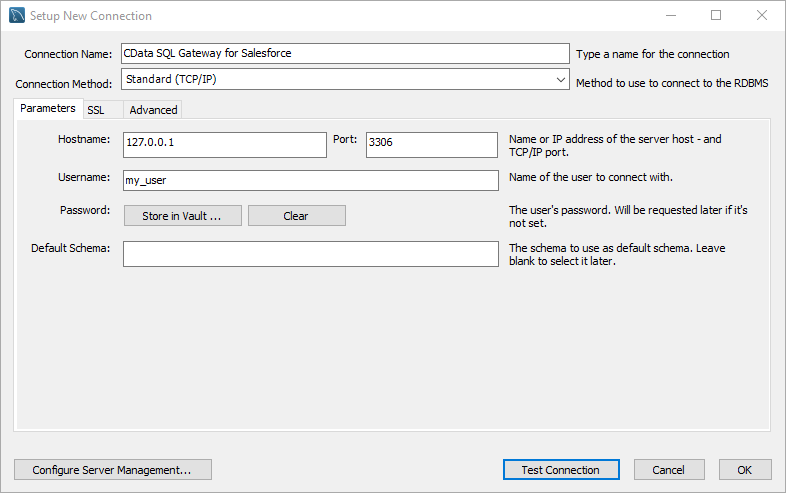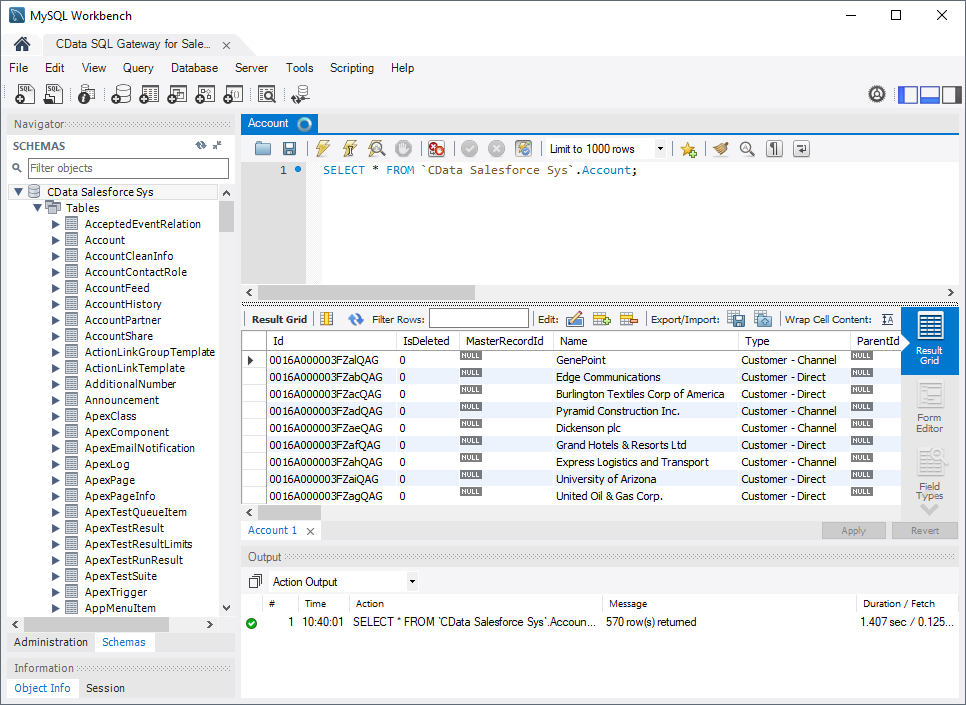Discover how a bimodal integration strategy can address the major data management challenges facing your organization today.
Get the Report →How to Query Certinia Data in MySQL Workbench
Execute MySQL queries against live Certinia data from MySQL Workbench.
You can use the SQL Gateway from the ODBC Driver for Certinia to query Certinia data through a MySQL interface. Follow the procedure below to start the MySQL remoting service of the SQL Gateway and work with live Certinia data in MySQL Workbench.
Connect to Certinia Data
If you have not already done so, provide values for the required connection properties in the data source name (DSN). You can use the built-in Microsoft ODBC Data Source Administrator to configure the DSN. This is also the last step of the driver installation. See the "Getting Started" chapter in the help documentation for a guide to using the Microsoft ODBC Data Source Administrator to create and configure a DSN.
There are several authentication methods available for connecting to Certinia: login credentials, SSO, and OAuth.
Authenticating with a Login and Token
Set the User and Password to your login credentials. Additionally, set the SecurityToken. By default, the SecurityToken is required, but you can make it optional by allowing a range of trusted IP addresses.
To disable the security token:
- Log in to Certinia and enter "Network Access" in the Quick Find box in the setup section.
- Add your IP address to the list of trusted IP addresses.
To obtain the security token:
- Open the personal information page on certinia.com.
- Click the link to reset your security token. The token will be emailed to you.
- Specify the security token in the SecurityToken connection property or append it to the Password.
Authenticating with OAuth
If you do not have access to the user name and password or do not want to require them, use the OAuth user consent flow. See the OAuth section in the Help for an authentication guide.
Connecting to Certinia Sandbox Accounts
Set UseSandbox to true (false by default) to use a Certinia sandbox account. Ensure that you specify a sandbox user name in User.
Configure the SQL Gateway
See the SQL Gateway Overview to set up connectivity to Certinia data as a virtual MySQL database. You will configure a MySQL remoting service that listens for MySQL requests from clients. The service can be configured in the SQL Gateway UI.

Query Certinia from MySQL Workbench
The steps below outline connecting to the virtual Certinia database created in the SQL Gateway from MySQL Workbench and issuing basic queries to work with live Certinia data.
Connect to Certinia through the SQL Gateway
- In MySQL Workbench, click to add a new MySQL connection.
- Name the connection (CData SQL Gateway for Certinia).
- Set the Hostname, Port, and Username parameters to connect to the SQL Gateway.
- Click Store in Vault to set and store the password.
- Click Test Connection to ensure the connection is configured properly and click OK.

Query Certinia Data
- Open the connection you just created (CData SQL Gateway for Certinia).
- Click File -> New Query Tab.
- Write a SQL query to retrieve Certinia data, like SELECT * FROM `CData Certinia Sys`.Account;

With access to live Certinia data from MySQL Workbench, you can easily query and update Certinia, just like you would a MySQL database. Get started now with a free, 30-day trial of the CData ODBC Driver for Certinia and the CData SQL Gateway.






